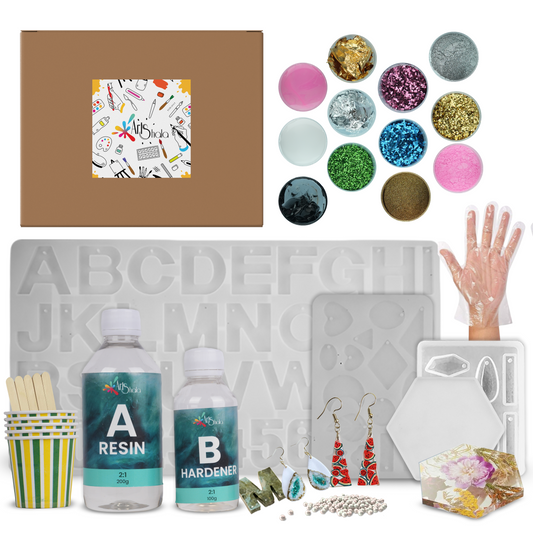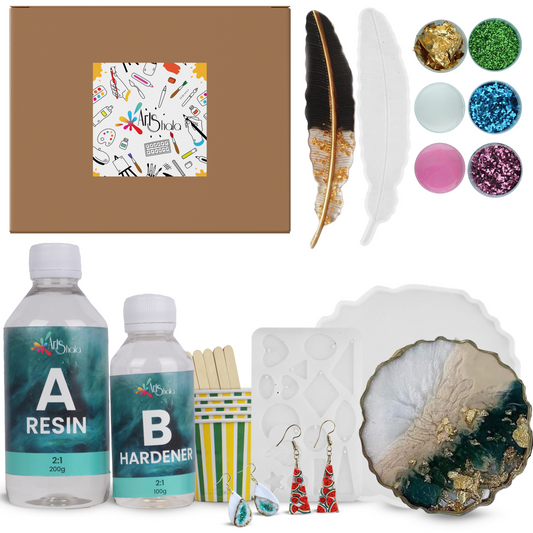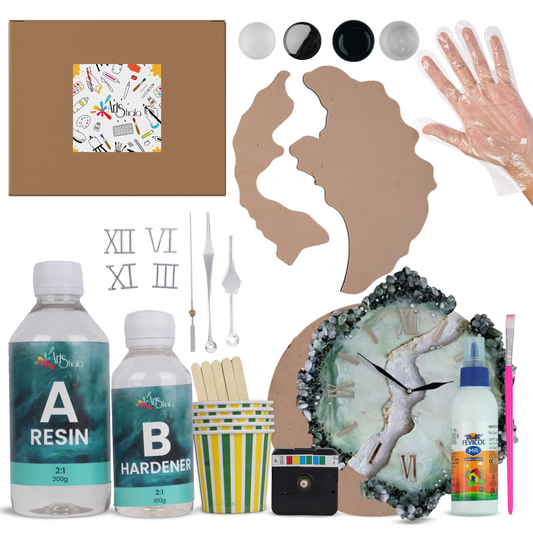How to Make Epoxy Resin Crystals: A Beginner's Guide
Resin crystals have become a popular craft, bringing a touch of elegance and brilliance to jewellery, home décor, and art projects. These beautiful creations are surprisingly achievable, even for beginners. This guide will walk you through the whole process, from gathering materials to achieving a flawless crystal finish. To learn more about such techniques, enrol in a resin art workshop.
What You'll Need to Make Resin Crystals?
- Crystal Clear Epoxy Resin: This is the foundation of your crystals. Choose a high-quality resin with a 1:1 mixing ratio (equal parts resin and hardener) for ease of use.
- Resin Hardener: This works with the resin to create a cured, solid form.
- Silicone Moulds: These come in various shapes and sizes, mimicking natural crystals or offering geometric designs. For versatility, opt for food-grade silicone.
- Mixing Cups and Stir Sticks: Disposable cups and popsicle sticks are perfect for small batches.
- Safety Gear: Gloves, respirators, and safety glasses are essential for protecting yourself from resin fumes and potential skin irritation.
- Optional Extras:
- Alcohol Inks or Mica Powders: These add vibrant colours and swirling effects.
- Glitter: For a touch of sparkle and a glamorous twist.
- Dried Flowers or Embellishments: Incorporate botanical elements or small charms for a unique look.
- Heat Gun or Torch (optional): Helps remove air bubbles from the resin.
- Sandpaper and Polishing Cloths: For smoothing and buffing imperfections (optional).
Setting Up Your Workspace
- Choose a well-ventilated area with a flat, protected surface. Cover the surface with newspaper or plastic sheeting for easy cleanup.
- Ensure reasonable ventilation by opening windows or using a fan.
- Wear gloves, safety glasses, and a respirator throughout the process.
Mixing the Resin
- Read the Instructions: Different resin brands may have slightly varying mixing times. Carefully read the manufacturer's instructions for optimal results.
- Measure Precisely: Use accurate measuring tools for equal parts resin and hardener. A slight imbalance can affect curing and clarity.
- Mix Thoroughly: Pour the measured substances into a clean mixing cup. Stir slowly and deliberately for at least three minutes, scraping the sides and bottom to ensure complete mixing.
- Letting it Settle: After mixing, allow the mixture to sit for 2-3 minutes. This allows air bubbles introduced during mixing to rise to the surface.
Colouring and Adding Effects (Optional)
- Alcohol Inks: Add a drop or two of alcohol ink to the mixed resin. Gently swirl the cup to create a marbled effect, or use a toothpick for precise patterns. Don't overmix, as excessive alcohol ink can disrupt curing.
- Mica Powders: For opaque or metallic colours, a tiny amount of mica powder goes a long way. Mix a small amount with a separate resin portion, then slowly incorporate it into the main batch to avoid clumps.
- Glitter: Add a sprinkle of glitter for a touch of shimmer. Avoid using too much, as it can influence the crystal's clarity.
- Dried Flowers or Embellishments: Carefully place these elements into the mould before pouring the resin. Ensure they are fully submerged to avoid air pockets.
Pouring the Resin
- Work Quickly: Resin has a limited working time before it starts to set. Once the mixed resin has settled, pour it into your mould.
- Slow and Steady Stream: Pour the resin slowly and steadily into the mould, aiming for a single central point to minimise air bubbles.
- Removing Air Bubbles:
- Gently Tapping: Tap the sides of the mould gently to release the trapped air bubbles that rise to the surface.
- Heat Gun (Optional): If using a heat gun, hold it safely from the mould and gently sweep the heat across the surface. The heat helps air bubbles rise and burst. Do not overheat the resin, as it can induce warping.
Curing and Demolding
- Curing Time: Refer to the manufacturer's instructions for the specific curing time of your chosen resin. Generally, it takes 24-48 hours for the resin to harden completely.
- Patience is Key: Wait to attempt to de-mould the crystals prematurely. Patience ensures a fully cured and properly formed crystal.
- Demolding: Once cured, gently twist and flex the mould to release the crystal. If the crystal seems stuck, try soaking the mould in warm water for a few minutes.
Finishing Touches (Optional)
Once your resin crystals have successfully de-moulded, you can add finishing touches to achieve a flawless or personalised look. Here are some options:
- Sanding and Polishing: For a perfectly smooth and precise finish, lightly sand the crystal with fine-grit sandpaper (around 1000 grit or higher). Then, buff with a polishing cloth to achieve a high gloss.
- Removing Excess Flash: The pouring process might leave a thin film of resin (flash) on the edges of the crystal. Use a sharp craft knife or nail clippers to trim away any excess flash carefully.
Advanced Techniques
For those who want to take their resin crystal creations to the next level, here are a few advanced techniques to explore:
- Crystal Clusters: Instead of pouring resin into individual crystal moulds, create a cluster effect by pouring into a more extensive mould with multiple cavities or carefully adhering to cured crystals with a small amount of uncured resin.
- Geode Effect: You can use a two-part pouring process to achieve a geode-like crystal with a hollow centre filled with sparkling druzy crystals. First, pour a coloured resin layer, allowing it to cure partially. Then, sprinkle crushed holographic glitter or tiny crystals on the tacky surface before pouring a transparent top layer.
- Inclusions: Embed small objects like dried flowers, insects (ethically sourced, of course!), or tiny gemstones within the resin for a unique and stunning look.
Safety Precautions
Resin can be an excellent crafting material, but it's crucial to prioritise safety throughout the process. Here are some essential precautions to remember:
- Always work in a well-ventilated area. Resin fumes can be irritating, so open windows or use a fan to provide proper air circulation.
- Wear protective gear (gloves, safety glasses, and a respirator) to protect your skin, eyes, and lungs from potential irritants.
- Work on a protected surface. Cover your workspace with newspaper or plastic sheeting to prevent spills from damaging surfaces.
- Never dispose of uncured resin or leftover materials down the drain. Dispose of them responsibly according to the manufacturer's instructions.
- Keep resin away from children and pets. Resin can be harmful if ingested.
Troubleshooting Tips
Even with careful planning, occasional hiccups might occur during the resin crafting. Here are some common issues and solutions:
- Air Bubbles: If air bubbles remain trapped in your cured crystals, it's usually best to accept them as a natural characteristic of handcrafted resin pieces. However, for a smoother finish next time, try using a heat gun more diligently or mixing the resin more slowly to minimise trapped air.
- Sticky Surface: If the surface of your cured crystal feels slightly sticky, it might not be fully cured. Allow the crystals additional curing time in a warm, dust-free environment.
- Cloudy Crystals: Cloudy crystals can occur due to improper mixing or using resin past its expiration date. Ensure thorough mixing and use fresh resin for optimal clarity.












